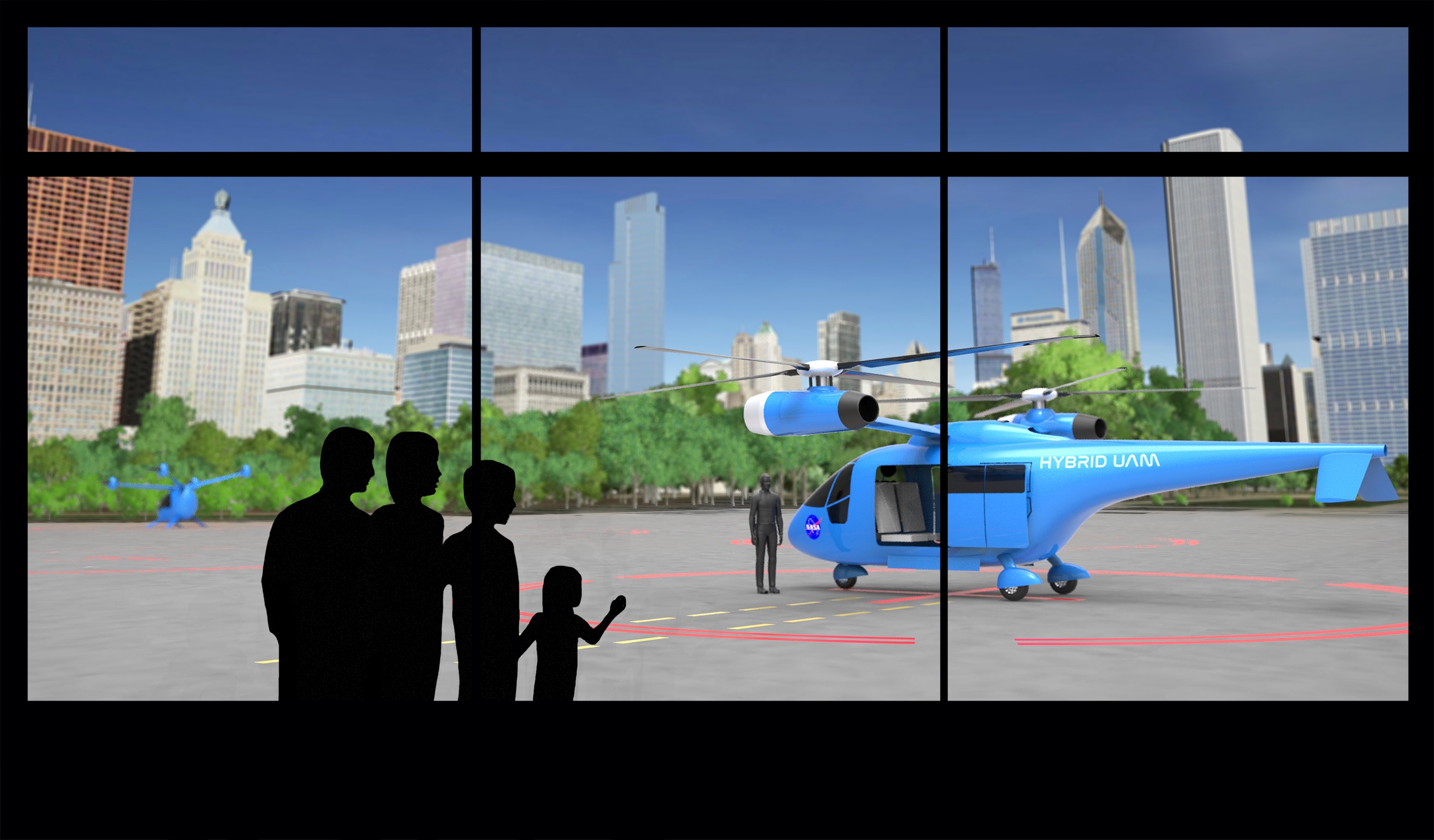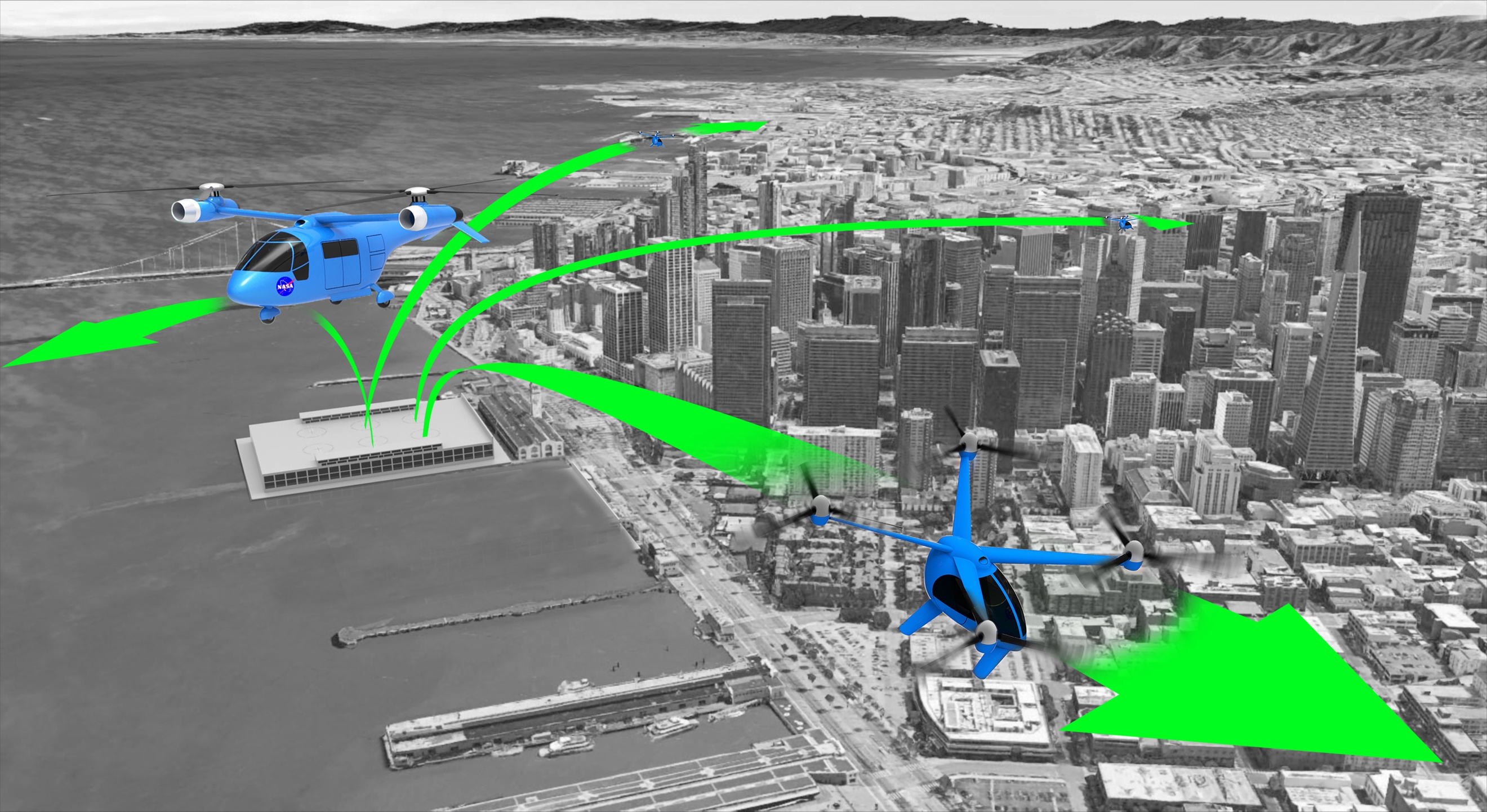Urban Air Mobility

NASA reference vehicles help establish the vision for a future where urban aviation will be a regular--yet still amazing--part of urban life.
Urban air taxi operations, also known as urban air mobility or on demand mobility applications, are enabled by vertical take-off and landing (VTOL) capability, power and energy requirements are minimized by using low disk-loading rotors, and short range requirements permit consideration of non-traditional propulsion concepts. The community of innovation has recognized that technology advances in structures, automation and control, energy generation-storage-utilization, and tools for design and analysis, coupled with pressures of resource availability and population density, make this the right time to explore new ways to move people and goods. The objective of the research program is to identify concept vehicles that can be used to focus and guide NASA research activities in support of aircraft development for emerging aviation markets, in particular VTOL air taxi operations.
To meet this objective, the designs are carried far enough to identify crucial technologies and research requirements, to explore a range of aircraft types, propulsion system types, and size, and to examinesensitivities to trades of requirements. While identifying relevant issues and major technical deficiencies is important, resolving all questions is not necessary, and component weight estimates and performance models can be the subject of future work. With this approach, the specific design choices made are not important, as long as primary and relevant research requirements are covered. Indeed, to these ends it is best that NASA concept vehicles be different in appearance and design detail from prominent industry arrangements.
In addition, technology development typically proceeds either of its own accord, or in response to an externally defined need. We are using specific aircraft conceptual designs in order to establish the feasibility of meeting a set of challenging vehicle requirements, and to quantify the levels of performance needed from component technologies in order to realize aircraft meeting those requirements. The conceptual designs and their requirements may serve as need statements that researchers can use to understand the impact of their work on the market for Urban Air Mobility (UAM). The concept vehicles described in the present paper are provided as reference vehicles, such that research and development may be prioritized by its quantifiable system-level payoff. We explore UAM aircraft requirements and technology trades. Dtudfies have focused on a 1200 lb payload weight–up to six passengers. A small quadrotor aircraft has been scaled up to meet these specific requirements, and a new type of aircraft, a "lift+cruise," has been added to the types of aircraft considered, because it has features which explore some particular technology trades relevant to aircraft being proposed by industry. NASA technology development includes not only physical hardware and flight vehicle software, but also the tools for performing design and analysis of aircraft system-of-systems. The concept vehicles and the design process itself have tested the ability of our tools and will lead to improvements going forward.

NASA concept vehicles are depicted operating within the highly urbanized environment of the San Francisco Bay Area.
Urban Air Mobility Vehicle Architecture Trends, C. Silva Download
Observation from Exploration of VTOL Urban Air Mobility Designs, W. Johnson and C. Silva Download
POINT OF CONTACT
Christopher Silva
NASA Ames Research Center
Moffett Field CA 94035-1000
Related Publications
- 1. Johnson, W., "Propulsion System Models for Rotorcraft Conceptual Design," AHS Fifth Decennial Aeromechanics Specialists' Conference, San Francisco, California, January 2014
- 2. Johnson, W. and Silva, C., "Observations from Exploration of VTOL Urban Air Mobility Designs," 7th Asian/Australian Rotorcraft Forum, Jeju Island, Korea, Oct 2018.
- 3. Silva, C., Johnson, W., Solis, E., "Concept Vehicles for VTOL Air Taxi Operations," AHS Technical Meeting on Aeromechanics Design for Vertical Lift, Holiday Inn at Fisherman's Wharf, San Francisco, CA, January 2018
- 4. Silva, C., Johnson, W., Antcliff, K.R., and Patterson, M.D., "VTOL Urban Air Mobility Concept Vehicles for Technology Development," 2018 Aviation Technology, Integration, and Operations Conference, AIAA Aviation Forum, AIAA 2018-3847, Dallas, TX, June 2018.